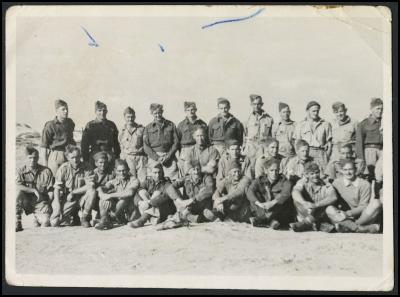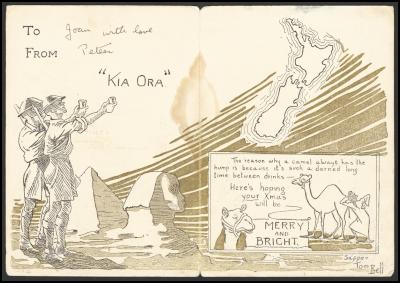Stories of WWII Sappers to Be Added to Turnbull
MEDIA RELEASE
For immediate release
5 February
2008
Stories of WWII Sappers to Be Added to Turnbull Library Collections

Click for big version
When World War II was declared, a young red-headed mining engineer, Peter Hamilton, was doing postgraduate work on the geology of the area surrounding Lake Monowai. He was born in 1918, the same year that his father, a member of the Auckland Mounted Rifles died in a hospital train en route from the Jordan Valley to Cairo.
Peter and his mining school friends rushed to enlist in 1939 and, as a young 2NZDiv sapper officer, he left New Zealand with the 2nd Echelon in early 1940. He didn't return to NZ until 1945.
The eleven oral histories that will be handed over to the Turnbull Library on 7 February are the result of Peter Hamilton's reluctance to talk about his wartime experiences and his elder daughter's determination to get some insight into what he had experienced through the recollections of other engineers who had fought with him.

Click for big version
The starting point was a Christmas card sent from Egypt to New Zealand at the end of 1941. Listed there were the names of the men in Number 3 Section 6th Field Company, Hamilton's first command. From those on the list available to talk, and through the networking of veterans, both officers and sappers, an oral history project emerged. The combined oral histories tell of what it was like to be a divisional sapper from the bitter times in Greece and Crete through the North African and Italian campaigns until the final days near Trieste.
In his introduction to Cody's Official History of New Zealand in the Second World War 1939 -1945 New Zealand Engineers Middle East Bernard Freyberg, Commander of the 2NZ Division, wrote of the divisional sappers:
'Through their skills in laying and lifting minefields they were into the most forward of the fighting throughout the campaigns in North Africa.
'When the Division moved to Italy the role of the engineers grew even more important. The success of operations depended largely upon their ability to build bridges quickly, frequently under fire, to clear minefields and to maintain roads under all conditions.'
The recollections of these men bring insight and explanation to Cody's official history. The project was coordinated by Lizzie Catherall and funded by an award in oral history from the Australian Sesquicentennial Gift Trust, established in 1990 as a gift to New Zealand from the Australian people.
High-resolution images can be downloaded
directly from this link:
http://www.natlib.govt.nz/about-us/news/media-releases/sappers-handover/
ENDS


 Air New Zealand: Raw Thrills - Air New Zealand's Most Popular Inflight Entertainment Revealed
Air New Zealand: Raw Thrills - Air New Zealand's Most Popular Inflight Entertainment Revealed Hustle Management: Celebrating 50 Years Of Music, Now And Then, With Mark Williams
Hustle Management: Celebrating 50 Years Of Music, Now And Then, With Mark Williams Massey University: Birdnapped Cockatoo Wins Quote Of The Year
Massey University: Birdnapped Cockatoo Wins Quote Of The Year LAWA: “Know Before You Go” – Check Summer Swimming Water Quality Online
LAWA: “Know Before You Go” – Check Summer Swimming Water Quality Online Official Aotearoa Music Charts: 2024 End Of Year Charts Have Been Published
Official Aotearoa Music Charts: 2024 End Of Year Charts Have Been Published Nielsen Book NZ: Nielsen BookData Announces 'In Too Deep' Is The Official New Zealand Number 1 Christmas Bestseller
Nielsen Book NZ: Nielsen BookData Announces 'In Too Deep' Is The Official New Zealand Number 1 Christmas Bestseller